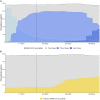Reduced COVID-19 morbidity and mortality in hemodialysis patients across the various Omicron sublineages-A retrospective analysis
- PMID: 37637818
- PMCID: PMC10448811
- DOI: 10.3389/fpubh.2023.1218188
Reduced COVID-19 morbidity and mortality in hemodialysis patients across the various Omicron sublineages-A retrospective analysis
Abstract
Introduction: Hemodialysis (HD) patients are a COVID-19 high risk population due to comorbidities and impaired immune response. Vaccines, advent of effective treatment and the emergence of novel variants have fundamentally changed the pandemic. We aimed to assess temporal changes of COVID-19 in HD patients of our catchment area, and risk factors for severe and fatal course.
Methods and materials: We retrospectively collected data from 274 patients admitted to the Medical University Graz, Austria for HD between 1st of May 2020 and 31st of August 2022. We analyzed clinical and demographic data between different COVID-19 waves and assessed factors associated with hospitalization, ICU admission and mortality by logistic regression. To further evaluate the dialysis at-risk population, we collected demographic and vaccination data between August 2021 and August 2022.
Results: Time of infection and SARS-CoV-2 sequencing data allowed for distinction of five separate waves of infection with different impact on the dialysis population: While in the initial four waves frequencies of hospitalization, necessity of critical care and mortality were around 60%, 10% and 20%, respectively. These events became rare during the large fifth wave, when Omicron had become the dominant variant. Although only 16.9% had to be hospitalized, this resulted in 29 hospital admissions, due to the high prevalence of COVID-19 during the Omicron era. Furthermore, we observed similar clinical outcomes with BA.4/5 as with BA.1/BA.2 Omicron sublineages. The proportion of previously infected increased simultaneously with the number of vaccination doses in our dialysis population. Vaccination at time of positivity and infection with an Omicron variant conferred protection against hospitalization and mortality in univariate analysis, but only infection with an Omicron variant remained a robust predictor for these outcomes in multivariable analysis.
Discussion: While a fourth of our at-risk population became infected during the Omicron wave, mortality was almost non-existent. Several concomitant factors have contributed to the decrease of COVID-19 severity in HD patients. This trend appears to be continued with BA.4/5, which was equally mild as BA.1 and BA.2 in our well vaccinated dialysis population.
Keywords: BA.4/5; COVID-19; Omicron; hemodialysis; vaccination.
Copyright © 2023 Schuller, Ginthör, Paller, Waller, Köstenbauer, Schreiber, Schabhüttl, Mischinger, Hafner-Giessauf, Rosenkranz, Eller and Eller.
Conflict of interest statement
The authors declare that the research was conducted in the absence of any commercial or financial relationships that could be construed as a potential conflict of interest.
Figures





Similar articles
-
Protective immunity of SARS-CoV-2 infection and vaccines against medically attended symptomatic omicron BA.4, BA.5, and XBB reinfections in Singapore: a national cohort study.Lancet Infect Dis. 2023 Jul;23(7):799-805. doi: 10.1016/S1473-3099(23)00060-9. Epub 2023 Mar 13. Lancet Infect Dis. 2023. PMID: 36924786 Free PMC article.
-
BNT162b2 vaccine protection against omicron and effect of previous infection variant and vaccination sequence among children and adolescents in Singapore: a population-based cohort study.Lancet Child Adolesc Health. 2023 Jul;7(7):463-470. doi: 10.1016/S2352-4642(23)00101-3. Epub 2023 May 15. Lancet Child Adolesc Health. 2023. PMID: 37201540 Free PMC article.
-
Evolution of SARS-CoV-2 variants of concern over a period of Delta and Omicron cocirculation, among patients hospitalized for COVID-19 in an Italian reference hospital: Impact on clinical outcomes.J Med Virol. 2023 Jun;95(6):e28831. doi: 10.1002/jmv.28831. J Med Virol. 2023. PMID: 37246793
-
Severity and outcomes of Omicron variant of SARS-CoV-2 compared to Delta variant and severity of Omicron sublineages: a systematic review and metanalysis.BMJ Glob Health. 2023 Jul;8(7):e012328. doi: 10.1136/bmjgh-2023-012328. BMJ Glob Health. 2023. PMID: 37419502 Free PMC article.
-
Outcome of Transplant Recipients Infected with Omicron BA.1 and BA.2: A Single-Center Retrospective Study in Saudi Arabia.J Epidemiol Glob Health. 2023 Mar;13(1):47-54. doi: 10.1007/s44197-023-00084-6. Epub 2023 Jan 10. J Epidemiol Glob Health. 2023. PMID: 36626091 Free PMC article. Review.
Cited by
-
COVID-19 Hospitalization and Mortality Trends Among US Dialysis Patients by Race/Ethnicity and Vaccination Status.Kidney Med. 2025 May 16;7(7):101026. doi: 10.1016/j.xkme.2025.101026. eCollection 2025 Jul. Kidney Med. 2025. PMID: 40613010 Free PMC article.
-
Single-Facility Analysis of COVID-19 Status of Healthcare Employees during the Eighth and Ninth Pandemic Waves in Japan after Introducing Regular Rapid Antigen Testing.Vaccines (Basel). 2024 Jun 9;12(6):645. doi: 10.3390/vaccines12060645. Vaccines (Basel). 2024. PMID: 38932374 Free PMC article.
-
Efficacy and safety of early administration of remdesivir in hemodialysis patients with COVID-19: A case report and literature review.Medicine (Baltimore). 2024 Nov 29;103(48):e40650. doi: 10.1097/MD.0000000000040650. Medicine (Baltimore). 2024. PMID: 39612460 Free PMC article. Review.
References
-
- Jager KJ, Kramer A, Chesnaye NC, Couchoud C, Sanchez-Alvarez JE, Garneata L, et al. . Results from the era-edta registry indicate a high mortality due to COVID-19 in dialysis patients and kidney transplant recipients across Europe. Kidney Int. (2020) 98:1540–8. 10.1016/j.kint.2020.09.006 - DOI - PMC - PubMed
-
- Alberici F, Delbarba E, Manenti C, Econimo L, Valerio F, Pola A, et al. . A Report from the brescia renal covid task force on the clinical characteristics and short-term outcome of hemodialysis patients with SARS-CoV-2 infection. Kidney Int. (2020) 98:20–6. 10.1016/j.kint.2020.04.030 - DOI - PMC - PubMed
-
- WHO . Tracking SARS-CoV-2 Variants. Available online at https://www.who.int/en/activities/tracking-SARS-CoV-2-variants/ (aaccessed 30 March 2023).
Publication types
MeSH terms
Supplementary concepts
LinkOut - more resources
Full Text Sources
Medical
Miscellaneous

